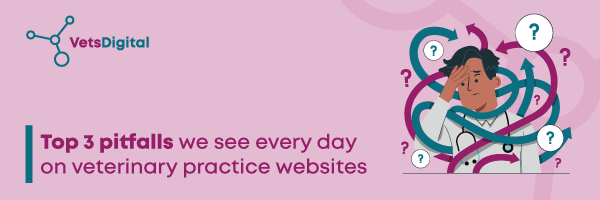The top 3 pitfalls we see every day on veterinary practice websites
August 15, 2024
At a time when standing out online for positive reasons is more important than ever for local businesses, we see a number of easily remedied issues on veterinary websites all the time.
To ensure that you are presenting your practice in the best possible light, here are the top three things we recommend checking your website for as soon as possible.

1. Your site isn’t optimised for mobile
Data shows that as of 2024, more than 60% [1] of all online traffic is conducted on a mobile device. So, with more of us using mobile devices when browsing online, it is critical to ensure that your practice website is fully optimised for mobile in order to deliver the seamless experience that your client base expects.
Mobile optimised websites adapt to suit all mobile device screen sizes, which ensures that your content is readable and loads efficiently. This level of versatility is essential to building trust with your audience and maintaining engagement, as veterinary websites that don’t deliver an optimal mobile experience often experience significantly higher bounce rates, reduced interaction, and fewer appointments booked. It also helps to ensure that your website is easy to browse, with clear navigation menus enabling your visitors to navigate to the information they are looking for without becoming frustrated.
Ensuring your site is optimised for mobile also has a number of search engine optimisation (SEO) benefits, which will boost the visibility of your practice and help you to connect with more potential clients. As a local business, this is particularly important as it can enhance your clinic’s standing in local SEO results for search terms, including ‘vet near me’ or ‘local veterinary practice.’
2. You still have a COVID19 notice in place
During the height of the pandemic, amidst the various lockdowns that were put in place by the government, it was sensible to ensure your website had a clear COVID-19 notice in place, which set out the rules in place at your practice.
However, while you still might have certain measures in place to protect your clients and your team, such as placing hand sanitiser on your reception desk, continuing to display a COVID19 notice on your website instantly makes your online presence feel outdated, which could have a detrimental impact on the number of potential clients contacting your practice to register and book an appointment.
3. There is no cookie banner or policy is displayed
A cookie notice, popup or banner is displayed when a user first visits your website and lets them know about the trackers and cookies that you’re using to provide a seamless experience to everyone who lands on your site.
In order to fully comply with GDPR [2] privacy regulations and the ePrivacy Directive [3], your website must display a cookie banner because it will ask users to consent to the storage of cookies on the device they are using to access your online content. However, it’s also worth noting here that clearly displaying your cookie policy can also ensure that you are presenting your practice as a trustworthy business that has a desire to be transparent with your visitors and customers.
There are various different cookie banner styles and layouts that you can use, which can be customised to align with your branding and web design. Banners that appear across the bottom of the screen when a user lands on your website for the first time tend to be the most popular option, as they aren’t overly intrusive and don’t cover up a large portion of your content. Floating popup banners are another popular choice and are generally positioned in either the bottom left or bottom right corner of the screen.
Please note that in order to be fully GDPR compliant, it is not enough to simply implement a basic cookie banner. Let’s take a closer look at the specific requirements your cookie notice must meet.
Your checklist for creating a fully GDPR-compliant cookie banner
– Display a cookie banner that is aligned with your branding and website design
– Ensure it is optimised for all devices
– Tell visitors about your site’s cookie usage in easy-to-understand language
– Ensure your banner is auto-translated in line with the language each user has set their browser to
– Offer granular accept and reject options for different categories of cookies
– Incorporate both accept and reject buttons
– Ensure all third-party scripts are automatically blocked until a user provides consent
– Provide a link to your cookie and privacy policies
– Enable users to revoke consent easily
– Maintain a record of consent to prove your compliance
If you’re a veterinary practice owner and you want to refresh your online presence but you’re not sure where to start, we can help. With more than 17 years of experience in building veterinary practice websites that deliver a seamless user experience and developing powerful digital marketing strategies that drive results, we know what works.
Please get in touch with our expert team today to find out how we can help your practice to thrive.
Resources:
Further Reading:
Categorised in: News, Web Design, Website


